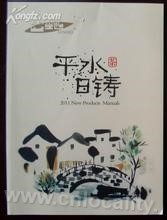welcomeSpecialty Foods Products!

Rizhu Tea, also known as "Rizhu Tea" and "Rizhu Snow Bud", is produced in Rizhu Ridge, Huiji Mountain, five miles southeast of Shaoxing County, and is one of the famous teas in China. Since the Song Dynasty, it has been listed as a tribute. According to the Record of Returning to the Field (Northern Song Dynasty Ouyang Xiu), "Grass tea is flourishing in Zhejiang, the product of Zhejiang, and the Japanese casting is the first." "Shu Lu" (Southern Song Dynasty, as high as Sun) says: "Huijishan tea is famous in the world by the day." In the Qing Dynasty, the Imperial Tea Bay was specially built in Rizhuling, and the premium tea was collected every year to pay tribute to Emperor Kangxi. Before liberation, the tea garden around Rizhuling was deserted, and the tea table of Rizhuling was on the verge of extinction. After liberation, Japanese tea was gradually restored. In 1980, the trial-produced Japanese-made tea was awarded as the first-class famous tea in the province at the famous tea appraisal meeting of the province's lending and marketing system. After that, the output increased year by year, reaching 500 kilograms in trial production in 1988. After it was put on the market, it was welcomed by consumers. The Japanese-cast tea is thin and slightly hooked, shaped like an eagle's claw, with silver showing, fresh and mellow taste, lasting fragrance, bright yellow soup color and unique charm. Japanese-made tea is usually picked in the first and middle of April, and the picking standards are strict, with one bud and one leaf to two leaves. After fresh leaves are harvested, they should be carefully selected, and fish scales, purple buds and diseased leaves should be removed to achieve uniform and complete bud leaves. Then put it in clean "white blue" and spread it for 3-4 hours, so that the green leaves are moderately wilted and the leaves are soft. Fresh leaves picked during the day were fried that night. The whole tea-making process is divided into five working procedures: water fixation, spreading and cooling, shaping and trimming, primary drying and full fire. Deactivation is carried out in an inclined pot, the pot temperature is higher than one, generally at 180 degrees Celsius, the amount of leaves is 1 kg, the bamboo is held in both hands, and the time is 6-7 minutes. The standard is to kill thoroughly and evenly, and the leaves and stems are broken continuously. After the water is removed, it is spread for 5-10 minutes, then divided into two pots, and then kneaded, fried, shaped and trimmed. The temperature in the flat pot is 70-80 degrees Celsius at first and then low, and it is appropriate to burn your hands below. The gesture is to hold the tea in the pot with your hands, spread it to the side of the pot, and then throw it into the pot from the tiger's mouth, while spreading it, until it is 70-80% dry. When the tea strips are tight, fine and round, take it out of the pot immediately. Next, fire the hair, put it on the drying cage, and spread gauze on it to prevent the tea pieces from falling into the electric stove plate and the smoke from burning, and turn it over for 6-7 minutes while drying, and finally fire it until it is dry. Pingshui Rizhu Tea is a geographical indication certification trademark.
Reprinted with attribution:
https://cnlocality.com/(Chinese Specialty Products)
other
consult:(+86)13225231905